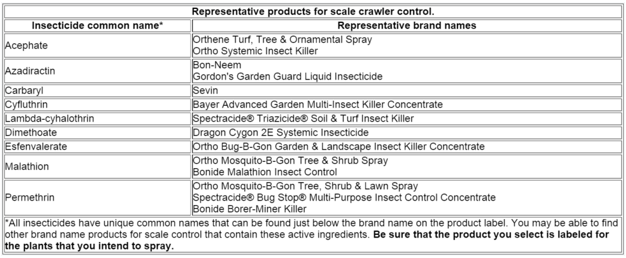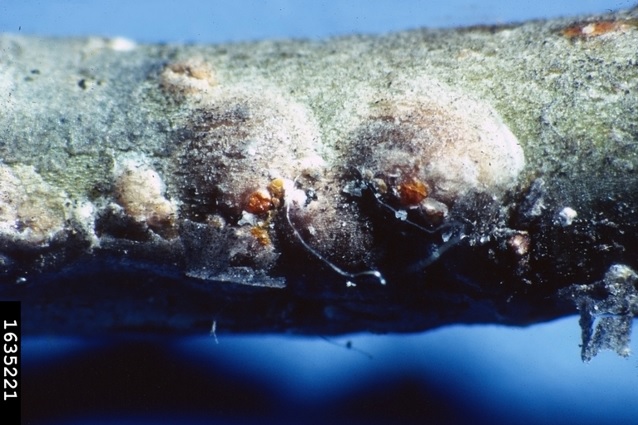Walnut Scale
ENTFACT-436: Walnut Scale Identification and Management | Download PDF
By Jonathan L. Larson, Extension Entomologist and Lee Townsend, Extension Specialist Emeritus
University of Kentucky College of Agriculture
Walnut Scale Fast Facts
- Female walnut scales are armored scale with a 1/8th inch diameter, grey, circular waxy cover with a red dot in the middle. Sometimes there are daisy shaped clusters of walnut scales, where males have taken up residence next to females and built their own waxy shell.
- Walnut scale can feed on multiple host species including walnut, red maple, boxwood, and hollies amongst others.
- Walnut scales can induce branch dieback, giving the appearance of a water-stressed plant.
- Control is usually performed by natural enemies, but horticultural oils can help eliminate scale crawlers.
Adult female walnut scales have 1/8th inch circular, grey, waxy shields that cover their bodies. The shield will also have a reddish dot towards the center. (Photo by John A. Davidson, Univ. Md, College Pk, Bugwood.org)
Potential Hosts
Walnut scale can be found feeding on walnut trees, but other hosts include boxwood, camellia, cherry, dogwood, hollies, peach, plum, red maple, sweetgum, and tuliptree. Walnut scales are not considered major pests in Kentucky but there have been reports of issues on red maple.
Symptoms and Pest Description
As is typical with armored scales, walnut scale feeding will induce branch dieback and canopy thinning. Infested plants can appear water stressed and there may be breakage in some twigs and branches. Armored scales do not produce honeydew, so we must rely on these other symptoms to notify us there is an issue.
Adult female walnut scales are 1/8" long nearly circular, flat, and gray with a reddish-brown spot. If the armor is peeled up, underneath there will be a pale yellow, circular scale insect. Occasionally, male scales will settle near the edge of female waxy covers and proceed to develop there. As a result, their armor and the female armor seem to converge into a daisy shape that helps to positively identify this pest.
Walnut scale females may have males that settle near them. As their waxy armor grows together, there can be characteristic “daisies” that form. Photo by Raymond Gill, California Department of Food and Agriculture, Bugwood.org
Life Cycle in Kentucky
There are two generations of walnut scale in a year. They overwinter as immature males and females that complete development their development the next spring. They will mate and females will produce eggs that hatch in mid-June. This generation will complete their development by August and new crawlers will emerge in late August to early September. These crawlers will find a spot to settle and prepare to overwinter to complete development the next spring.
Management
Scales tend to thrive on stressed plants. Following a recommended fertility program and watering regime will promote plant health. However, over-fertilization favors scale buildup. If practical, improve plant sites to reduce stress and promote growth. You can prune out small infestations to try and eliminate the issue or prune out sections of a large scale problem in order to make chemical control more feasible.
There are two options when considering management of euonymus scales, doing a systemic treatment or treating the crawlers directly. Whichever you choose, management may take repeated applications over a couple of growing seasons.
Treating with Systemic Insecticides
Dinotefuran (Orthro Tree & Shrub is one possible trade name) can be used against armored scales such as walnut scale. A systemic insecticide helps to give you control without reliance on broadcast sprays on the plant. This helps keep insecticide residues contained within the plant you wish to protect and helps to ensure the product will affect the pests you are targeting. Dinotefuran should be applied after the tree has bloomed in order to avoid causing undue harm to pollinating insects. Walnut scale is not usually at levels that would require systemic insecticide intervention and it may be more prudent to pursue the following strategy.
Treating Crawlers Directly
Crawlers are the most susceptible to control stage of a scale insect’s life. scale crawlers can be challenging to control though since they will utilize dead scale armor and then build their own. To best deal with populations of this scale, you might first prune out the most heavily infested twigs and then monitor for crawler emergence. Once they begin to coat themselves in their waxy armor, insecticide applications have little to no effect. You can visually check for crawlers in June and then again in August/September or you can place pieces of black electrical tape (sticky side out) or double-sided tape near scale populations and monitor the tape for the crawlers and treat following the initial find.
Horticultural oils kill by suffocation or after penetrating over-wintering stages of the insect. Consequently, they may not be effective where several layers of scale coverings have accumulated. Insecticidal soaps are long chain fatty acids that kill susceptible insects through direct contact. Like horticultural oils, they require thorough coverage. Soaps leave no residue so repeated applications may be needed for some pests. These products may burn the foliage of sensitive plants, such as Japanese maple, so check the label for information about the plant species that you intend to treat.
A variety of natural and synthetic insecticides are labeled for use as sprays to control scale crawlers on landscape trees and shrubs. While the residual life of these products is generally longer than oils and soaps, timing, coverage, and precautions on damage to some plant species are very similar to those for oils and soaps.
Below are some options for scale insect crawler control.

Revised: 2/21
CAUTION! Pesticide recommendations in this publication are registered for use in Kentucky, USA ONLY! The use of some products may not be legal in your state or country. Please check with your local county agent or regulatory official before using any pesticide mentioned in this publication.
Of course, ALWAYS READ AND FOLLOW LABEL DIRECTIONS FOR SAFE USE OF ANY PESTICIDE!
Images: University of Kentucky Entomology unless otherwise specified.


